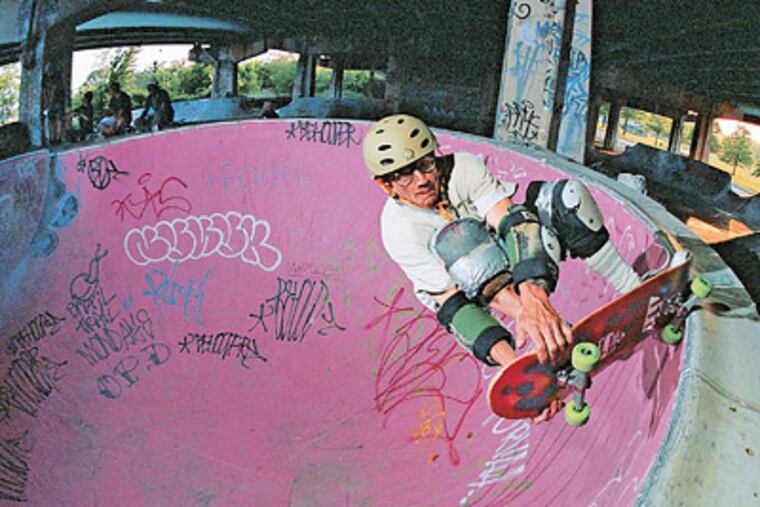'FDR Skatepark': A fast-paced slice of Philadelphia
Under an I-95 overpass in South Philadelphia, local skateboarders have built a wild world for themselves. They've raised the scaffolding under the ramps, smoothed the concrete in the bowls, and painted and repainted the skate park with care.

FDR Skatepark
A Visual History
By Nicholas Orso, Phil Jackson, Scott Kmiec
Schiffer Publishing. 168 pp. $34.99
nolead ends nolead begins
Reviewed by Joelle Farrell
Under an I-95 overpass in South Philadelphia, local skateboarders have built a wild world for themselves.
They've raised the scaffolding under the ramps, smoothed the concrete in the bowls, and painted and repainted the skate park with care.
Buried in the shaded gravel lot at the back of Franklin Delano Roosevelt Park, the skate park remains an untamed patch of Philadelphia, where seemingly anything goes. The spirit preserved there is exhilarating and terrifying, just like the rugged obstacles that skaters rush toward, sometimes crashing in a heap, sometimes nailing a trick that draws shouts of approval from people standing on the walls.
To capture FDR's spirit is no easy feat. In the book FDR Skatepark: A Visual History, three longtime skateboarders compiled more than 100 photos that take readers under the bridge to catch a glimpse of what goes on there. All profit from the book will go for maintaining and upgrading the skate park. (In addition to the usual online and bookstore sales, the volume is available at Exit Skate Shop, 825 N. Second St.)
The authors interviewed park regulars and included their words in an appendix, but the real power of the book comes from its images.
"It's such a visually striking place that that just seemed the way to go about it," said Phil Jackson, 26, a freelance photographer who, along with Scott Kmiec and Nicholas Orso, produced the book. "We wanted to just let the photos tell the story and keep it clean and simple."
The division makes sense. Josh Marcinizyn, known as "Delaware Josh," interviewed 17 park regulars and transcribed the discussions verbatim. For those who know FDR celebrities like Loudini, Bud Baum, or Steve Faas, the tales are old war stories about fights, fires, and the time the cops broke up the park's annual Fourth of July celebration. That year, 2005, the fighting got out of hand and a couple of people were slashed by a man wielding a box cutter.
One of Jackson's favorite pictures, taken by Ryan Hendon, shows a nearly three-inch cut on a young man's bare back, the blood staining the white elastic band of the underwear exposed by his sagging jeans. His left arm is also cut, and blood runs over a red-star tattoo down onto his hand.
It's a single instance that shows how that day got out of hand, Jackson said.
The book includes photos from dozens of people, including professionals like Jackson and amateurs who used throwaway cameras and Polaroids.
Stunning landscape shots illustrate the sheer size of the park and its odd placement. One picture shows skateboarders building as cars speed overhead.
I particularly liked some of the black-and-white portraits: a teenager, black hair falling over his face, bites his bottom lip as he flips off the camera; a man with spiked blond hair gazes intently to his right as he smokes a joint; a girl comforts a young man who lies on his back, grimacing after a fall.
There are also incredible pictures that capture the second when a skateboarder hits a trick on the edge of a deck or reaches a peak height over the coping.
As for wildness, the book includes pictures of naked skating, fireworks, men shooting mice, a girl passed out in an open car trunk, and a line of police officers who intervened in the fights in 2005.
For park regulars, it's a trip down memory lane. For anyone else, it's a slice of life in a place that remains untouched by the concerns for safety and security that have changed playgrounds, parks, and nearly every aspect of recreational life.